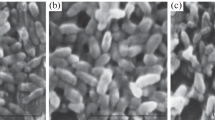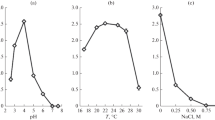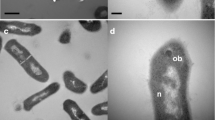Summary
The ciliate Tetrahymena thermophila was grown in a synthetic nutrient medium at various amino acid concentrations. Before the beginning of the experiments the cells were starved for 4 h in a pH buffer. They were inoculated at an initial density of only 250 cells per ml. Under these conditions the cells grew and multiplied at only the two highest amino acid concentrations used. Hemin or phospholipids were found to stimulate cell growth at the lower amino acid concentrations. The mechanism behind this stimulatory effect is unknown, but may be connected with the maintenance of an adequate energy flow under adverse conditions. These additions represent an improvement of the synthetic medium for Tetrahymena.
Similar content being viewed by others
Abbreviations
- PPYS:
-
proteose peptone, yeast extract, and salts medium
References
Davis JP, Stephens GC (1983) Determination of net flux of amino acids in Tetrahymena pyriformis. J Comp Physiol 152:27–33
Davis JP, Stephens GC (1986) Regulation of system L amino acid transport by Tetrahymena thermophila. J Comp Physiol B 156:891–895
Dunham PB, Kropp DL (1973) Regulation of solutes and water in Tetrahymena. In: Elliott AM (ed) Biology of Tetrahymena. Dowden, Hutchinson and Ross, Stroudsburg, Pa., pp 165–198
Florin-Christensen M, Florin-Christensen J, Tiedtke A, Rasmussen L (1989) New aspects of extracellular hydrolytic enzymes in lower cukaryotes. Eur J Cell Biol 48:1–4
Florin-Christensen M, Florin-Christensen J, Tiedtke A, Rasmussen L (1990) The role of secreted acid hydrolases in the utilization of complex nutrients by Tetrahymena. Microb Ecol 19:311–316
Hoffmann EK, Rasmussen L (1972) Phenylalanine and methionine transport in Tetrahymena pyriformis. Biochim Biophys Acta 226:206–216
Hoffmann EK, Rasmussen L, Zeuthen E (1970) Evidence for a common transport system for a group of amino acids. C R Trav Lab Carlsberg 38:133–143
Kidder GW, Dewey VC (1951) The biochemistry of ciliates in pure culture. In: Lwoff A (ed) Biochemistry and physiology of ciliates, 1. Academic Press, New York, pp 323–400
Szablewski L, Andreassen PH, Tiedtke A, Florin-Christensen J, Florin-Christensen M, Rasmussen L (1991) Tetrahymena thermophila: growth in the synthetic nutrient medium in the presence and absence of glucose. J Protozool 38:62–65
Tiedtke A, Rasmussen L (1988) Lysosomal enzymes in extracellular digestion in the unicellular eukaryote Tetrahymena. J Cell Physiol 136:554–556
Tiedtke A, Rasmussen L (1989) Constitutive secretion of acid hydrolases in Tetrahymena thermophila. J Protozool 36:378–382
Tiedtke A, Hünseler P, Rasmussen L (1988) Growth requirements of a new food-vacuole-less mutant of Tetrahymena. Eur J Protistol 23:350–353
Author information
Authors and Affiliations
Rights and permissions
About this article
Cite this article
Christensen, S.T., Schousboe, P., Ghiladi, M. et al. Nutritional stress in Tetrahymena relieved by addition of hemin or phospholipids. J Comp Physiol B 162, 107–110 (1992). https://doi.org/10.1007/BF00398335
Accepted:
Issue Date:
DOI: https://doi.org/10.1007/BF00398335




